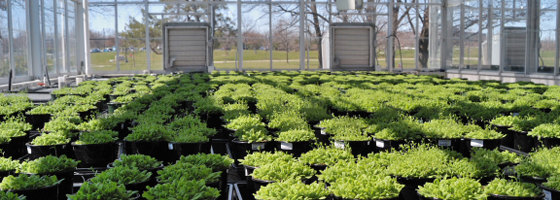Ohio State greenhouse nurtures ‘fruit fly of the plant world’

The Arabidopsis Biological Resource Center at Ohio State University was established in 1991 with funding from the National Science Foundation. Part of the center’s job is to meet demand for seed of the arabidopsis plant, which is widely used for genetic modeling.
“A lot of the plants we’re growing are for seed production,” said Joan Leonard, greenhouse coordinator. “Arabidopsis is a good example. We call it the ‘fruit fly of the plant world,’ and it takes about six to eight weeks to go from seed to plant.”
Arabidopsis is one of the many plants that will benefit from a new LI-COR PAR sensor being installed on campus. It will help manage light schedules for greenhouse plants. By changing out a 20-year old sensor, Leonard says the facility will gain energy efficiency and continue growing many types of plant seeds used for research.
 “The LI-COR is part of a weather station and will be used to monitor light levels,” said Joan Leonard, greenhouse coordinator. “We have 10 different growing rooms and each runs independently.”
“The LI-COR is part of a weather station and will be used to monitor light levels,” said Joan Leonard, greenhouse coordinator. “We have 10 different growing rooms and each runs independently.”
Accounting for ten different rooms and needs of different plants is important, including making sure each plant gets just the right amount of light.
“Some plants need 12, 14, or 18 hours of light each day. Some need lower levels,” said Leonard. “But if you take a plant like corn, which has a high light threshold, you might just leave the lights on.”
Leonard says the sensor will help the facility to manage and conserve electricity by turning on and off supplemental lighting when necessary.
“We can also program shade curtains to run on light levels,” said Leonard. “That’s good for heat retention in the winter and shade in the summer. Basically, we’re trying to make it a smarter system.”




0 comments